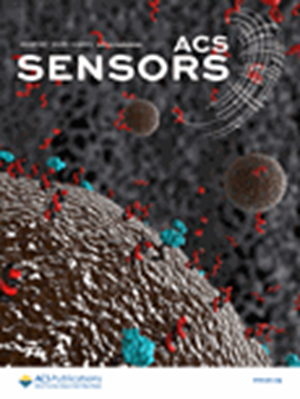Transparent TiO2/MoO3 Heterojunction-Based Photovoltaic Self-Powered Triethylamine Gas Sensor with IoT-Enabled Smartphone Interface
IF 9.1
1区 化学
Q1 CHEMISTRY, ANALYTICAL
引用次数: 0
Abstract
Conventional gas sensors encounter a significant obstacle in terms of power consumption, making them unsuitable for integration with the next generation of smartphones, wireless platforms, and the Internet of Things (IoT). Energy-efficient gas sensors, particularly self-powered gas sensors, can effectively tackle this problem. The researchers are making significant strides in advancing photovoltaic self-powered gas sensors by employing diverse materials and their compositions. Unfortunately, several of these sensors seem complex in fabrication and mainly target oxidizing species detection. To address these issues, we have successfully employed a transparent, cost-efficient solution processed bilayer TiO2/MoO3 heterojunction-based photovoltaic self-powered gas sensor with superior VOC sensing capabilities, marking a significant milestone in this field. The scanning Kelvin probe (SKP) measurement reveals the remarkable change in contact potential difference (−23 mV/kPa) of the TiO2/MoO3 bilayered film after UV light exposure in a triethylamine (TEA) atmosphere, indicating the highest reactivity between TEA molecules and TiO2/MoO3. Under photovoltaic mode, the sensor further demonstrates exceptional sensitivity (∼2.35 × 10–3 ppm–1) to TEA compared to other studied VOCs, with an admirable limit of detection (22 ppm) and signal-to-noise ratio (1540). Additionally, the sensor shows the ability to recognize TEA and estimate its composition in a binary mixture of VOCs from a similar class. The strongest affinity of TiO2/MoO3 toward the TEA molecule, the lowest covalent bond energy, and the highest electron-donating nature of TEA may be mainly attributed to the highest adsorption between TiO2/MoO3 and TEA. We further demonstrate the practical applicability of the TEA sensor with a prototype device connected to a smartphone via the IoT, enabling continuous surveillance of TEA.

基于透明 TiO2/MoO3 异质结的光伏自供电三乙胺气体传感器与支持物联网的智能手机接口
传统的气体传感器在功耗方面存在很大障碍,不适合与下一代智能手机、无线平台和物联网(IoT)集成。高能效气体传感器,尤其是自供电气体传感器,可以有效解决这一问题。研究人员采用多种材料及其组成,在推进光电自供电气体传感器方面取得了重大进展。遗憾的是,其中一些传感器的制造工艺似乎比较复杂,而且主要针对氧化性物种的检测。为了解决这些问题,我们成功地采用了一种透明、低成本、基于双层 TiO2/MoO3 异质结的光电自供电气体传感器,该传感器具有卓越的挥发性有机化合物传感能力,是该领域的一个重要里程碑。扫描开尔文探针(SKP)测量显示,TiO2/MoO3 双层膜在三乙胺(TEA)气氛中经紫外光照射后,接触电位差(-23 mV/kPa)发生了显著变化,表明三乙胺分子与 TiO2/MoO3 之间的反应活性最高。在光电模式下,与所研究的其他挥发性有机化合物相比,该传感器对三乙醇胺的灵敏度更高(2.35 × 10-3 ppm-1),检测限(22 ppm)和信噪比(1540)也令人满意。此外,该传感器还能识别三乙醇胺,并估算出同类挥发性有机化合物二元混合物中的三乙醇胺成分。TiO2/MoO3 与三乙醇胺分子的亲和力最强、共价键能最低、三乙醇胺的电子负载性最高,这可能主要归因于 TiO2/MoO3 与三乙醇胺之间的吸附力最大。我们通过物联网与智能手机连接的原型设备进一步证明了三乙醇胺传感器的实用性,从而实现了对三乙醇胺的连续监测。
本文章由计算机程序翻译,如有差异,请以英文原文为准。
求助全文
约1分钟内获得全文
求助全文
来源期刊

ACS Sensors
Chemical Engineering-Bioengineering
CiteScore
14.50
自引率
3.40%
发文量
372
期刊介绍:
ACS Sensors is a peer-reviewed research journal that focuses on the dissemination of new and original knowledge in the field of sensor science, particularly those that selectively sense chemical or biological species or processes. The journal covers a broad range of topics, including but not limited to biosensors, chemical sensors, gas sensors, intracellular sensors, single molecule sensors, cell chips, and microfluidic devices. It aims to publish articles that address conceptual advances in sensing technology applicable to various types of analytes or application papers that report on the use of existing sensing concepts in new ways or for new analytes.
 求助内容:
求助内容: 应助结果提醒方式:
应助结果提醒方式:


